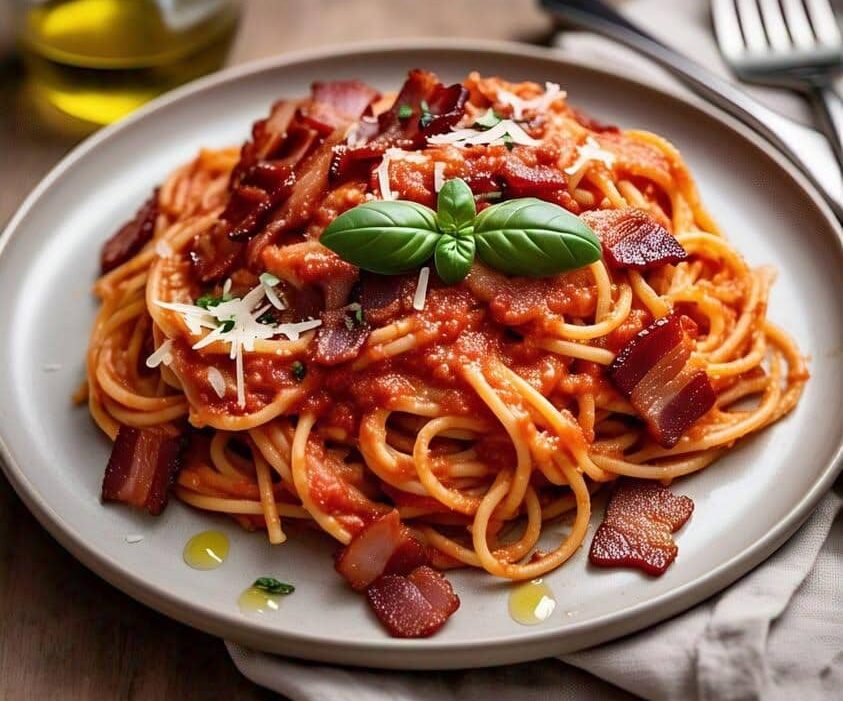Pasta all’Amatriciana is a bold and flavorful Italian dish that hails from the town of Amatrice, near Rome. This classic recipe is known for its rich tomato sauce infused with guanciale (cured pork cheek) and Pecorino Romano cheese, creating a perfect balance of savory, tangy, and slightly spicy flavors. Amatriciana pasta is a beloved staple in Roman cuisine, often served with bucatini, spaghetti, or rigatoni for the ultimate Italian dining experience.
The Origins of Amatriciana Pasta
The history of Pasta all’Amatriciana dates back to the 17th century, evolving from an earlier dish called Gricia, which was made without tomatoes. When tomatoes were introduced to Italian cooking, the sauce transformed into the rich, red Amatriciana sauce we know today. The dish quickly gained popularity in Rome and became one of the four classic Roman pasta sauces, alongside Cacio e Pepe, Carbonara, and Gricia.
Ingredients You Will Need
For the Amatriciana Sauce:
- 2 tablespoons olive oil
- 4 oz (120g) guanciale, diced (or pancetta as a substitute)
- 1/2 teaspoon red pepper flakes (adjust to taste)
- 1 small onion, finely chopped (optional, but adds sweetness)
- 2 cloves garlic, minced
- 1 can (14 oz / 400g) crushed tomatoes
- 1/2 teaspoon salt (adjust to taste)
- 1/2 teaspoon black pepper
- 1/2 teaspoon dried oregano (optional)
- 1/4 cup (25g) grated Pecorino Romano cheese (for serving)
For the Pasta:
- 12 oz (340g) bucatini, spaghetti, or rigatoni
- 1 tablespoon salt (for boiling water)
Optional Additions:
- Extra Pecorino Romano for garnish
- Fresh parsley or basil for added freshness
- A splash of white wine for deglazing the pan
Step-by-Step Cooking Instructions
Step 1: Cook the Pasta
Bring a large pot of water to a boil. Add 1 tablespoon of salt, then cook the pasta according to package instructions until al dente (about 8–10 minutes). Before draining, reserve 1/2 cup of pasta water to adjust the sauce’s consistency later.
Step 2: Sauté the Guanciale
In a large skillet, heat 2 tablespoons of olive oil over medium heat. Add the diced guanciale and cook for 4–5 minutes until crispy and golden. If you’re using pancetta, follow the same method. The fat will render out, creating a flavorful base for the sauce.
Step 3: Add Garlic and Red Pepper Flakes
Once the guanciale is crispy, add the red pepper flakes, followed by the garlic and chopped onion (if using). Sauté for about 30 seconds to 1 minute, just until fragrant.
Step 4: Deglaze and Simmer the Sauce
Pour in the crushed tomatoes and stir well to combine with the guanciale and aromatics. If you want extra depth, deglaze the pan with a splash of white wine before adding the tomatoes. Let the sauce simmer on low heat for 15–20 minutes, stirring occasionally. Season with salt, black pepper, and oregano (if using).
Step 5: Combine Pasta and Sauce
Add the cooked pasta directly into the sauce, tossing well to coat every strand. If the sauce is too thick, add a splash of the reserved pasta water to reach your desired consistency.
Step 6: Garnish and Serve
Serve the Amatriciana Pasta hot, topped with grated Pecorino Romano cheese and an optional sprinkle of fresh herbs. Enjoy immediately!
Tips for the Perfect Amatriciana Pasta
- Use Guanciale for Authentic Flavor: Guanciale has a deeper, richer taste than pancetta, making it essential for an authentic Amatriciana sauce.
- Balance the Spice: Adjust the red pepper flakes to your preference for a milder or spicier kick.
- Don’t Overload with Tomatoes: The sauce should be balanced between the acidity of the tomatoes and the richness of the guanciale and cheese.
- Use the Right Pasta: Bucatini is the traditional choice, but spaghetti or rigatoni also work well.
- Save Pasta Water: Adding a bit of reserved pasta water helps the sauce cling beautifully to the pasta.
Amatriciana Pasta is a true Italian classic, offering a simple yet bold and flavorful dining experience. Whether you’re recreating this dish for a weeknight meal or a special Italian feast, its savory, slightly spicy, and cheesy goodness is guaranteed to impress. Try this authentic Amatriciana recipe and enjoy a taste of Roman culinary tradition!





